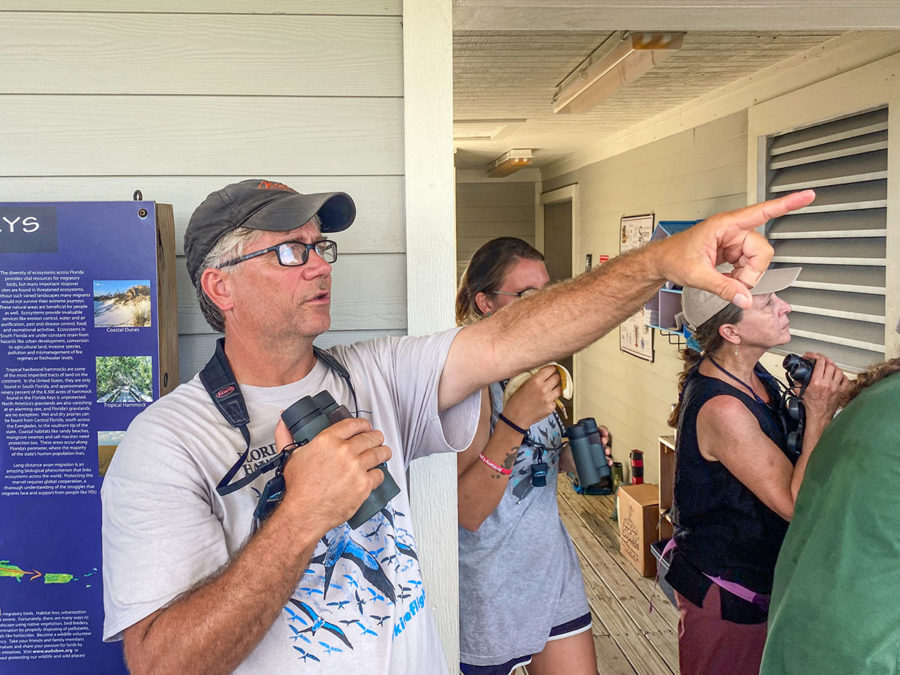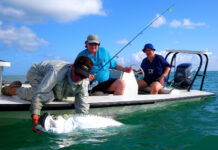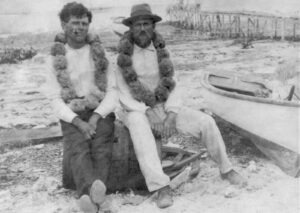Jeff Bouton is not a superstitious person, though some days it is near impossible to believe that.
By “some days” I mean every Oct. 10, which Florida Keys Hawkwatch considers Día De Los Peregrinos, or Day of the Peregrines.
Bouton is always convinced it will be the best and “birdiest” day of the season. It’s reassuring to know this belief doesn’t derive from anything occult so much as from data. He’s like one of those baseball obsessives who can tell you the RBIs and batting averages of every player on the field. Except he obsesses on migrating birds of prey, and peregrine falcons most of all.
“I’ve been here every year for 10/10 since 2016, except, of course, for 2017 when the count season got Irma-ed out of existence,” Bouton said a few weeks back, on Oct. 10 of this year.
His showing up on Oct. 10, 2016 was most likely inspired by what happened on Oct. 10, 2015. A total of 1,506 peregrines were counted that day. The Florida Keys Hawkwatch consistently counts more peregrine falcons than any other count on the planet. And 1,506 was the greatest single-day count anywhere ever.
I’d sprained my ankle pretty badly the day before, but when I heard the numbers they were seeing at the hawkwatch, my wife drove me up. I crutched around the platform and caught sight of the last 400 or 500 birds. It was one of the more crazy and intense things I’d seen in my life, and I’m pretty sure I would have felt that way even if I wasn’t out of my head on Vicodin.
It’s that day Bouton always cites first as his reason for coming on Oct. 10.
“The next highest day of 651 was on 10/10 in 2012,” Bouton said. “Then last year, we had 609 on 10/10, which was our fourth best single-day peregrine falcon flight ever. So statistically I think it’s safe to say this is the peak day. Granted it can move one way or the other, depending on conditions, but more often than not, 10/10 is the best day for peregrines. And it’s kind of magical.”
It should be noted that in the 1970s peregrines east of the Mississippi had pretty much been wiped out by DDT, and their numbers have slowly been coming back over the decades.
Bouton works as the sales and marketing manager at Kowa Sporting Optics, which produces binoculars and spotting scopes. Kowa is one of the main sponsors of the hawkwatch project, and Bouton is one of the small core group of people who make it happen every year.

We weren’t sure he was going to make it this year, though. He lives with his wife and son in Port Charlotte and they were hit pretty hard by Hurricane Ian. The storm tore away part of their roof, which let the water in and caused the ceiling to collapse.
“The worst part of it was I lost a lot of my bird books that I’ve been collecting for the last 40-some years,” he said. “It’s kind of an emotional thing. It’s like they’re treasures reminding me of different times and adventures I’ve had over the last – let’s not do the math.”
Bouton said he discovered birdwatching when introduced to it by his sixth grade teacher, Kevin Griffith.
“He later introduced me to a snowy owl on a winter day walking home from school when I was 16. And then, three months later, he introduced me to the Braddock Bay Hawk Watch. I went there and had a day of over 20,000 raptors that passed literally mere miles from my childhood home, where I’d lived my entire life,” he said.
“I remember I went home around mid-afternoon that same day, went into my backyard, looked up, and lo and behold, there they were. They’d been soaring over my house and over my head my entire childhood and I never noticed them. So that was the hook. And then, because I lived literally at one of the best spring hawkwatch sites in North America, I got intimately involved in the hawkwatch there and then into hawk banding after that. So that all kind of led me down a dark path,” he said.
Bouton went on to work as a hawk bander and counter at places like Cape May, New Jersey, before moving to Alaska to do raptor surveys and guide for close to a decade. (He also worked as a karaoke host, which makes him prone to breaking into song at any moment.)
He moved to Florida in the mid-2000s to be closer to family. I met him around that time. We spent an afternoon trapping and banding raptors when there was a seasonal trapping blind set up across the road from Curry Hammock State Park, and we’ve seen each other a couple times every year since.
So we were all more than pleased when the clouds of chaos created by Hurricane Ian parted somewhat, and Jeff had enough of a respite to make a last-minute run down to the count for Día De Los Peregrinos.
The peregrines, at first, seemed to be unaware of the date on the calendar. By 3 p.m. we’d only counted 80 of them, and they’d all been really high and distant. And then the rain came, first one band, then another. We figured we wouldn’t even make it to 100 birds, which seemed like the minimum number to have it feel like a successful day for that time of year (even if that was more peregrines than most people would see in their lifetime).
But then the weather cleared some, and the world felt a little refreshed. Peregrines started appearing again, lower and closer now, moving fast. You could see the brightness in the throats of the adults, and the occasional bulge of a recent meal. We counted another 33 birds in less than an hour.
It was officially quitting time.
“One hundred and thirteen. That’s a good number to quit at,” Jeff said.
But we all stayed and kept counting.


















